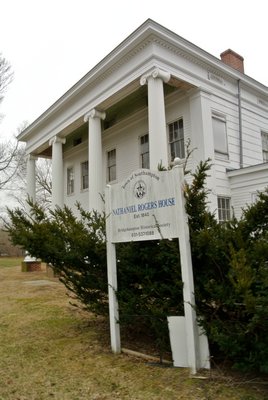
Five years after renovations began, the Nathaniel Rogers house, on the windswept corner of Montauk Highway and Ocean Road in Bridgehampton, was open to the public last Thursday for the first time in about three years.Nearly 70 people attended a free tour, with dozens more on a waiting list. Guests weaved in and out of rooms undergoing meticulous restoration, spying plastered walls, temporary floorboards and unfinished ceilings. John Eilertsen, executive director of the Bridgehampton Historical Society, led the way.
At 6,000 square feet, with two-story columns out front, the towering 19th-century Greek Revival building, once fully restored, will complete a trinity of historical structures serving as the western gateway in and out of Bridgehampton—along with the Topping Rose House, formerly the Bull’s Head Inn, across the street, and the War Monument perched in the middle of Montauk Highway.
In 2003, the Bridgehampton Historical Society purchased the house with the help of contributions from community members and in partnership with Southampton Town, which appropriated $2.5 million to purchase the land through its Community Preservation Fund. The historical society then gave the house to the town, but it will remain the building’s steward.
Envisioned as the society’s headquarters, the Nathaniel Rogers’ home’s crumbling facade has slowly been remodeled. The most visible changes have been the restored columns and a fresh coat of white paint on the exterior. Some not-so-visible roof repairs have also been done. Still to be completed are restoring the balustrades, or decorative railings, around the roof’s perimeter; replicating the cupola; and restoring the windows and doors, as well as the front, side and rear porches, Mr. Eilertsen explained this week.
Built in 1824 by Abraham Topping Rose, who also built the Bull’s Head Inn, the Nathaniel Rogers home represents three historic time periods, during which its owners made unique physical alterations. There were, however, several occupants in between.
The original house was federal in style, with two rooms downstairs and two rooms upstairs. It underwent a dramatic remodeling in 1840 under the auspices of Nathaniel Rogers, a renowned painter and shipbuilder. Mr. Rogers turned the home into a Greek Revival—adding the iconic columns out front, a cupola on the roof, balustrades, an outdoor summer kitchen and four large rooms in front of the house. Much of the wood trim, as well as ceiling and floor moldings, are from the 1840s era. Mr. Rogers lived in the house for only four years before his death in 1844.
His wife was deeded the house, and she gave it to her son. But in 1857, it was sold to whaling captain James Huntting and his wife, Martha, who owned it until around 1873, when they sold it to Augustus and Mary DeBost.
The DeBost family was part of the original Southampton Summer Colony, and they owned the house only until 1881, after which it fell into several hands over the years. This included Miles B. Carpenter who ran it as an inn, known as the Hampton House, and his successor Edward Storm. Mr. Storm also operated a railroad line from Bridgehampton to Sag Harbor called The Scoot until the 1940s, when it was closed, likely due to the prevalence of cars, according to Julie Greene, curator and archivist at the Bridgehampton Museum.
Then, in 1894, the Nathaniel Rogers home was sold to John Hedges and Frank Hopping for $5,370, and they transformed it into a fashionable inn, keeping the Hampton House name.
“They did most of the interior changes, so they put new facings on some of the fireplaces, wainscoted some of the walls and ceilings, and expanded the attic to give them more rooms to rent out,” said Mr. Eilertsen. In fact, one of the fireplaces is made with stones from Gardiners Island, after a member of the Hopping family reportedly traded an unknown good with Lion Gardiner for them.
The inn had about 8 to 10 rooms, as well as two dining rooms and one breakfast room on the first floor. During the winter, many local teachers rented the rooms, and in the summer, they were asked to move up to the third floor, so that the inn’s seasonal guests could enjoy the cooler second floor.
The building was damaged in the 1938 hurricane and never fully regained its former glory, but it operated as an inn until 1949. In 1952, the last innkeeper, Caroline Hopping, leased the front yard to Esso gas station. She died that same year, and for the next half century it was the residence of James B. Hopping and his family.
Given the home’s rich history, the restoration will reflect its evolution, with the exterior showcasing Nathaniel Rogers’s influence, while the interior celebrates the style of the Hampton House. Thus far, this project has cost more than $5 million. The town has committed another $3.1 million, and the historical society is looking to raise another $1 million on top of that. It’s expected to take about two more years to complete the restoration.
Ultimately, the space will house exhibition rooms, community research areas and a place to record stories on local history. The house will also have a gift shop, a visitors welcoming area and administrative space.
“We view this as a community project,” said Mr. Eilertsen. “It’s something we’re doing with the community and for the community.”